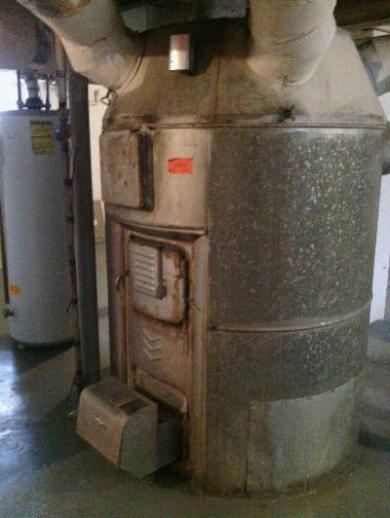Rethinking the …
Rethinking the Gravity Furnace
The principle is simple enough: hot air rises (because it’s lighter), cold air falls (because it’s heavier). What’s wrong with this illustration is that, traditionally, the cold air return pipes were at least twice as big as the hot air pipes off the top of the furnace.
The second thing wrong with the picture is that it has some of the hot air vents in the centre of the house. In practice the cold air return grate was in the centre, usually at the foot of the staircase to the second floor in the front hall.
The criticism I’ve found about them on line is that they were horribly inefficient but this is unfair because a good gravity furnace could run for 12 hours with a single charging of coal and heat a two-and-a half storey brick home. Like all coal-fired systems, it could be closed down or turned up with ease by means of the damper control which was a small chain system usually mounted on the wall of the main floor.
OK, that’s all in the past. Let’s rethink the basic idea.
Consider taking a high efficiency free-standing gas stove burner (using outside air) and combining that with a modern version of the large pipe gravity furnace. The whole thing could be controlled by a pizoelectric powered thermostat and wouldn’t need an electric-motor-driven fan.
By using the latest technology, you’d get great thermal efficiency and by using gravity to move the heat around, you’d eliminate the costs of the air handler. True, the pipes would fill up most of the basement, but when was the last time you went down there anyway?
You would also be warm and toasty during a power failure and could invite your neighbours over to keep warm.
It’s worth thinking about.


Interesting and a fun read. I’ve never seen one (one of your points). Occasionally, in Salem, Oregon we run across an old steam heater. I look forward to reading more.
Chris Stewart, SRES is a Real Estate Broker with Windermere Pacific West Properties in Salem, Oregon. One of her specialties is working with boomers and seniors over 55 who are downsizing, changing lifestyle, moving into retirement, or moving into assisted living. She is an active book club member and former Team Oregon Instructor
@ ChrisStewart, Hi Chris, While I was on this particular inspection I was asked by the potential buyer and the realtor, What is the cost to replace this old dog and did they have to replace it right away? My comment to them was that “this system is in fine working order and they could probably continue using it as long as it is properly maintained over the next few years (maybe even up to 10 years). The system can be removed and a new high efficiency furnace and air conditioning unit could be installed for between $4,000 and $7,500. In my opinion there is no need to replace this unit if the lack of air conditioning is not a factor to the home owner.
Vincent Cameron
Wow this post really helped me out. I appreciate it A LOT!
This post was so helpful. Thanks!